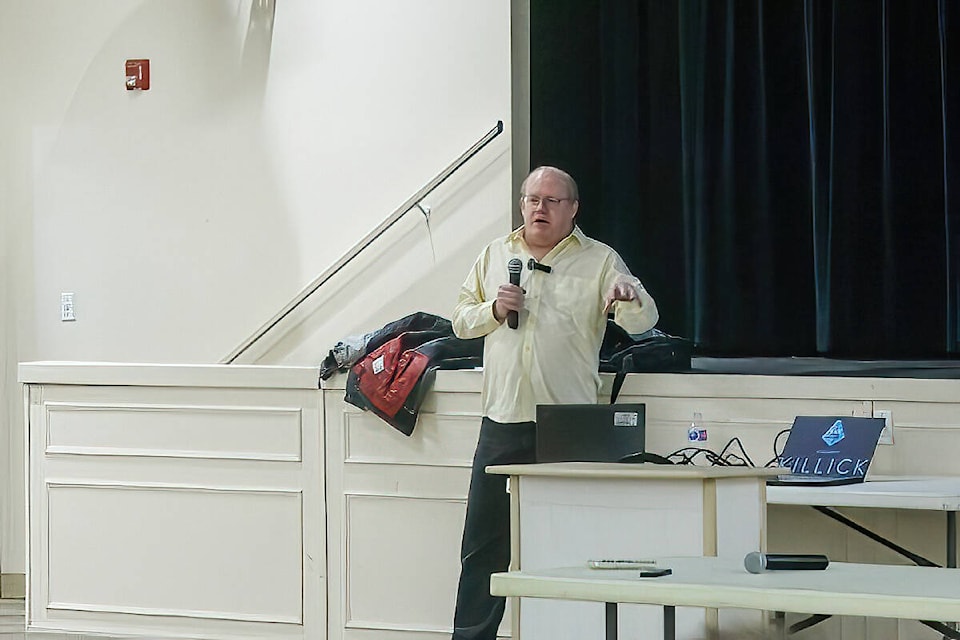Carson Ellis
For the Stettler Independent
The Battle River Alliance for Economic Development (BRAED) hosted a two-part Agriculture Industry Forum at the Castor Community Hall on Thursday, March 14.
The first part focused on drought and drought reduction efforts in the Battle River area, while the second discussed agricultural research and development in the area.
Speaking first in the afternoon session was Francois Paradis. Paradis is the Director of Applied Research at Lakeland College.
Paradis noted Agriculture and Agri-foods industry employs approximately 2.3 million people, and Canada is the fifth largest exporter after China, Brazil, and the U.S.
Some of the key challenges in the Ag industry are climate changes such as flooding and droughts, as well as labour, which currently has a vacancy rate of 7.4% that cost an estimated $3.5 billion in 2022 sales.
Another challenge that is expected to cause issues is the Canadian government’s planned 30% reduction in fertilizer use by 2030.
Paradis says that the two main ways for the Ag industry to combat the challenges are through Process Innovation including production techniques and crop genetics and Product Innovation such as new tools and equipment such as tractors and animal monitoring technologies. These allow the producer to increase production and profitability. Paradis says there is a very ‘high benefit-cost ratio for agriculture research.’
Lakeland College has 45-50 research projects annually. These projects are focused on commercial agriculture including crops (canola, cereals, and pulses) as well as work on livestock, particularly cattle, but also on bison, sheep, and dairy cows.
The objective of most of the projects is to address and alleviate the challenges facing the industry.
Lakeland research includes the development of (Sweet) Lupin which is a high-protein crop with several benefits. It’s grown largely in Australia and Europe and is an alternative to soybeans which don’t grow very well in northern climates.
It is the highest protein pulse crop available, higher than peas and fava beans. Of the three types of Sweet Lupins, narrow-leaf lupin seems to grow the best in the region. One benefit is they are economically similar, as well as similar in size, which makes it easier to handle without special equipment. It is also a good choice for animal feed due to its protein rate.
Another innovation that Lakeland has been working on is remote monitoring of livestock. One technology they have been working with has been drone usage. Paradis says that the use of drones for livestock monitoring reduces animal stress in the herds, this is particularly useful with bison producers.
Khalil Ahmed, Manager and Communication Coordinator with the Battle River Research Group talked about what their organization focuses on, and how they have been working towards their goals.
The group operates out of Forestburg and works to provide timely relevant, and unbiased information directly to farmers. They currently have three full-time employees and a part-time bookkeeper. This was also the first year they were able to hire three summer students to help with their projects. The group serves the counties of Paintearth, Stettler, Camrose Flagstaff, and Beaver.
Future projects include drone schools, beef marketing seminars, and information presentations on agriculture grants and programs.
Mario Orellana and Neil Blue who are with the Alberta Government were the last part of the afternoon forum. Orellana is the Senior Attraction Officer with Alberta Agriculture and Irrigation, while Blue is a Provincial Crop Market Analyst with the department.
Orellana’s office works largely with municipalities to find proper sites for potential investors looking to come to the province. He says that since 2015, there have been 332 investment projects with a $2.1 billion value, creating approximately 4,000 jobs. Orellana also demonstrated the site-finding tool that his office maintains on the Alberta Government website which helps potential investors get an idea of what is available across the province.
Neil Blue spoke on crop markets. He spoke about the causes of uncertainty in the markets. Blue also explained that a lower Canadian dollar is better for Canadian producers than American. This is due to American buyers looking for cheaper markets and can invest confidently once the dollar is stable.
Blue summarized various points of the market including World Wheat Usage, which has surpassed production. Blue addressed barley prices being down but did note there is a strong demand for oats. He was also pleased to report that despite drought conditions, especially in the area, lentils had managed to withstand much of the drought conditions well.
The forum was concluded with closing remarks from BRAED chair Stan Schulmeister. Schulmeister said it had been an interesting day and thanked everyone for coming out. He also thanked the presenters who attended for taking the time to speak at the forum, and answer questions.
